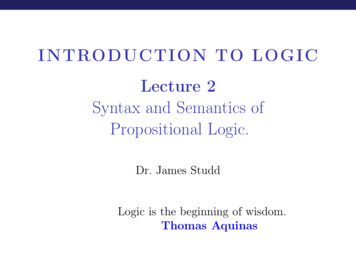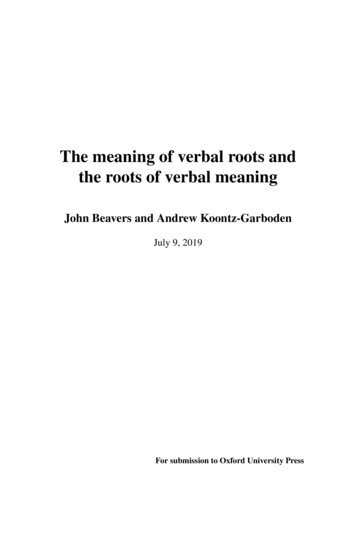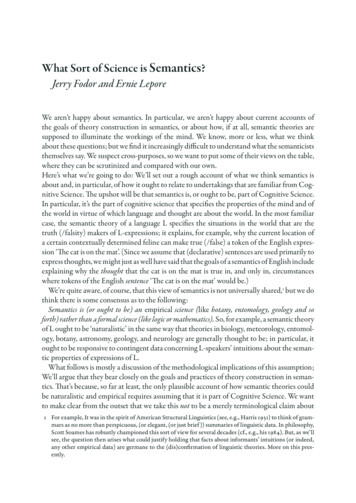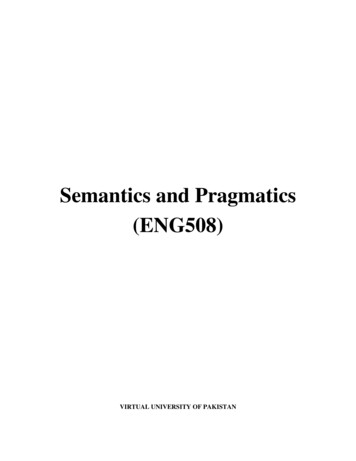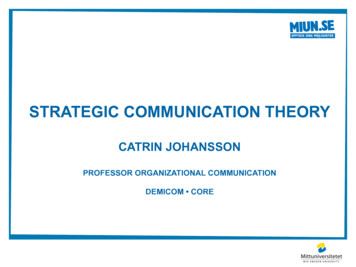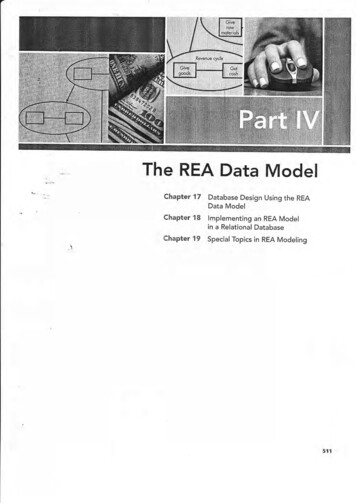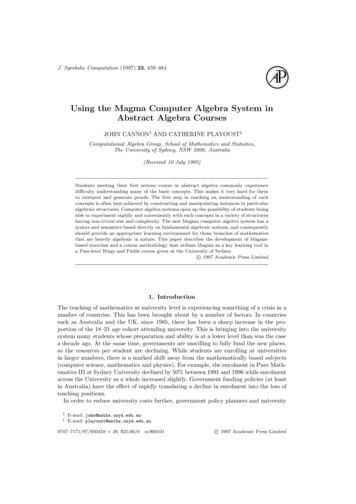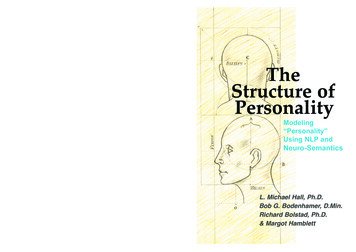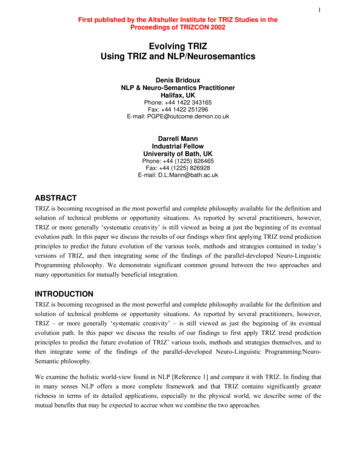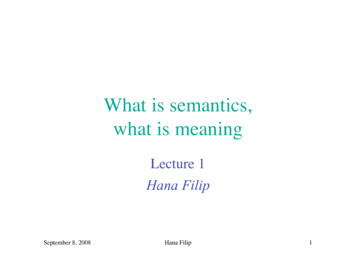
Transcription
What is semantics,what is meaningLecture 1Hana FilipSeptember 8, 2008Hana Filip1
What is semantics? Semantics is the study of the relation between form andmeaning– Basic observation: language relates physical phenomena (acousticblast we produce when we speak, chalk marks on the board, etc.)to meanings– How do we get from certain brute physical facts to meanings?– How do we get from physics to semantics? The crucial question of linguistics:How are form and meaning systematically related in anadequate grammar of natural language?September 8, 2008Hana Filip2
The form-meaning linkin linguisticsphonetics phonology morphology syntaxsemantics pragmatics SOUNDSMEANINGSeptember 8, 2008Hana Filip3
The form-meaning linkin linguisticsphonetics phonology morphology syntaxsemantics pragmatics SOUNDSMEANINGPhonetics studies the physical side of linguistic utterances—thearticulation and perception of speech sounds (articulatory, acoustic andauditory).September 8, 2008Hana Filip4
The form-meaning linkin linguisticsphonetics phonology morphology syntaxsemantics pragmatics SOUNDSMEANINGPhonology is the study of the sound patterns of human language.– Speech sounds as physical entities may be infinitely varied, but when they function aselements in a given language, as phonological units, they are highly constrained.– Native speakers of any language intuitively know which sequences of speech soundsare words or could be words in their language.EnglishEnglish-likeNot English-likeCzech tongue twisterbluegrueprststrc prst skrz krk– What are the smallest meaning distinguishing units ( phonemes) in a givenlanguage? Example: cat - sat - bat - matSeptember 8, 2008Hana Filip5
The form-meaning linkin linguisticsphonetics phonology morphology syntaxsemantics pragmatics SOUNDSMEANINGMorphology is the study of the structure of words and the smallest meaningbearing units and how they combine into words:– allowable combinations of morphemes: un-able, to un-do, *un-house– new word formation: to pulver-ize, to woman-ize, to google“You don't get to be a verb unless you're doing something right” (Nunberg on the effect ofGoogle on our collective consciousness, 2003, in “The Nation: Search Engine Society; AsGoogle Goes, So Goes the Nation”)September 8, 2008Hana Filip6
The form-meaning linkin linguisticsphonetics phonology morphology syntaxsemantics pragmatics SOUNDSMEANINGSyntax is the study of the formation of sentences, how words arecombined to larger units than words, to phrases and sentences that arewell-formed strings in a given language*portrait Rembrandt painted that a A portrait that Rembrandt painted September 8, 2008Hana Filip7
The form-meaning linkin linguisticsphoneticsphonology morphology syntaxsemanticspragmatics SOUNDSMEANINGSemantics is the study of meaning expressed by elements of any language, characterizableas a symbolic system.It is the goal of linguistic semantics to describe the meaning of linguistic elements and tostudy the principles which allow (and exclude) the assignment of meaning tocombinations of these elements. A complete and an adequate semantic theory– characterizes the systematic meaning relations between words and sentences of alanguage, and– provides an account of the relations between linguistic expressions and the thingsthat they can be used to talk about (De Swart 1998, p.2).September 8, 2008Hana Filip8
The form-meaning linkin linguisticsphoneticsphonology morphology syntaxsemanticspragmatics SOUNDSMEANINGSemantics is the study of meaning expressed by elements of any language, characterizable asa symbolic system.It is the goal of linguistic semantics to describe the meaning of linguistic elements and tostudy the principles which allow (and exclude) the assignment of meaning tocombinations of these elements. A complete and an adequate semantic theory– characterizes the systematic meaning relations between words and sentencesof a language, and– provides an account of the relations between linguistic expressions and the thingsthat they can be used to talk about (De Swart 1998, p.2).September 8, 2008Hana Filip9
The form-meaning linkin linguistics Question: How is a meaningful sentence built up from its meaningful parts all theway down to individual words?Dog bites man ordinary, expected event, barely something worthwhile reportingMan bites dog an unusual, infrequent event, which is more likely to be reported– Same words man, dog, bites with the same meaning– different structure leads to a different meaning of a whole sentence– structure overtly manifested in the differences in word order indicates how man anddog are related to the verb bites Conclusion: The meaning of a complex expression is determined by its structure and themeanings of its constituents—once we fix what the parts mean and how they are puttogether we have no more leeway regarding the meaning of the whole. This is thePRINCIPLE OF COMPOSITIONALITY (Frege’s Principle), a fundamentalpresupposition of most contemporary work in semantics.We cannot study meaning without structure.September 8, 2008Hana Filip10
The form-meaning linkin linguisticsWe cannot study meaning without structure.There are certain aspects of structure (syntax, morphology) that may be fruitfullystudied without reference to meaning (semantics). However, if we are interestedin language as a means of communication, we do not want to study syntax for itsown sake (De Swart 1998, p.9-10).September 8, 2008Hana Filip11
The form-meaning linkin linguisticsphonetics phonology morphology syntaxsemantics pragmatics SOUNDS MEANINGThe simplest cases of meaning are those in which the speaker says a sentence and meansexactly and literally what he says.It’s warm in here.More complicated cases: the speaker utters a sentence, means what he says, but alsomeans something more. The literal meaning of a sentence and what the speaker intendsto convey when he uses it, utters it, for example, then come apart in various waysIt’s warm in here.(i) Sentence (literal) meaning: assertion about temperature(ii) Speaker’s intended meaning or utterance meaning (one among many): commandOpen the window, please!September 8, 2008Hana Filip12
The form-meaning linkin linguistics Even more complicated case: An American soldier example (Searle 1965 “Whatis a speech act?”)“Suppose that I am an American soldier in the Second World War and that I am captured byItalian troops. And suppose also that I wish to get these troops to believe that I am aGerman officer in order to get them to release me. ( ) But let us suppose I don’t knowenough German or Italian to do that. ( ) they don’t know enough German ( ) Let ussuppose I know only one line of German, which I remember from a poem I had to memorizein a high school German course. Therefore I, a captured American, address my Italiancaptors with the following sentence: Kennst du das Land, wo die Zitronen blühen?”This is a line from Johann Wolfgang von Goethe’s novel Wilhelm Meisters Lehrjahre,which is translated as ‘Knowest thou the land where the lemon trees bloom?’“I want my captors to be deceived into thinking that what I mean is ‘I am a German officer’ ,but part of what is involved in the deception is getting them to think that that is what thewords which I utter mean in German.”September 8, 2008Hana Filip13
The form-meaning linkin linguisticsKennst du das Land, wo die Zitronen blühen?(i) Sentence meaning: Knowest thou the land where the lemon trees bloom?(ii) Speaker’s intended meaning/ utterance meaning: I am a German officer.However, this example does not mean that we can use ANY string of words withANY intended meaning. Wittgenstein (in Philosophical Investigations) mentionsthat we cannot say it’s cold here and mean it’s warm here.“The reason we are unable to do this is that what we can mean is a function ofwhat we are saying. Meaning is more than a matter of intention, it is also a matterof convention.” (Searle 1965) The crucial question of pragmatics:How is the sentence meaning related to speaker’s intended meaning?September 8, 2008Hana Filip14
The form-meaning linkin linguisticsphonetics phonology morphology syntaxsemantics pragmatics SOUNDSMEANINGSemantics studies literal, context-independent meaning, the constant meaning thatis associated with a linguistic expression in all of its occurrencesPragmatics is the study of situated uses of language, the study of language inrelation to the users of language, the study of linguistic communication as asocial activitySeptember 8, 2008Hana Filip15
The form-meaning linkin linguistics Pragmatics is also concerned with how we DO things with words– There are certain utterances that change facts in the worldI hereby declare you husband and wife.vs. #I hereby scramble and fry you.(This is not how you get your eggs cooked)Austin. J. 1962. How to Do Things with Words?September 8, 2008Hana Filip16
What is semantics? What is meaning?September 8, 2008Hana Filip17
What is meaning? ‘Aboutness’ of natural language– A noise that I make when I speak or a scribble that I produce whenI write words in English or a sign-language gesture I make arephysical objects that convey meanings, they are about something– We use language to communicate, to talk about things in the world,people and their properties, relations between people, events, inshort about the way the world is, should be, could have been – The property of ‘aboutness’ of linguistic signs (or symbols) is oneof the defining properties of natural languages, it is what asemantic theory of natural languages tries to captureSeptember 8, 2008Hana Filip18
Where is meaning? Can we define meanings in terms of their physical properties? The answer is ‘no’, there are 3 main arguments for this answer:1. Generally, there are no physical features that all meaningful noises orsets of marks have in common which serve to differentiate them fromother signals or noises.2. Usually there is no resemblance between a name and the thing it is thename of. Linguistic forms usually lack any physical resemblance withthe entities that they stand for.3. Not only do languages vary in their vocabularies, but also within onelanguage the relation between the words and what they stand for maychange (ex. gay).In sum, the connection between a word and what it stands for isARBITRARY. “The ARBITRARINESS of the linguistic sign” (Ferdinand deSaussure, 1916, Cours de linguistique générale) is one of the definingproperties of human language.September 8, 2008Hana Filip19
Where is meaning? Indirect relation between word and worldWORD houseCONCEPT THING IN THE WORLDTHOUGHTIDEASENSEpossibly IMAGE September 8, 2008Hana Filip20
Where is meaning? Indirect relation between word and worldWORD houseCONCEPT THING IN THE WORLDTHOUGHTIDEASENSEpossibly IMAGE ?IS IT IN YOUR MIND?September 8, 2008Hana Filip21
Where is meaning?Gold is getting more and more expensive.What idea, concept, thought or image do you think of when you hear thissentence?For EVERY PERSON, the word gold evokes a DIFFERENT PICTURE,IDEA, CONCEPT, etc.; yet that does not prevent us all from using theword with the same meaning.This means that the word gold applies to something general, or possiblyeven universal.September 8, 2008Hana Filip22
Where is meaning? Indirect relation between word and worldWORD houseCONCEPT THING IN THE WORLDTHOUGHTIDEASENSEpossibly IMAGE Is the concept somethingoutside your mind that yousomehow latch onto?September 8, 2008Hana Filip23
Where is meaning?September 8, 2008Hana Filip24
Where is meaning? SUMMARY– The meaning of words cannot be derived from theirphysical properties,– it cannot be reduced to the real-world objects or theirperception, and– it cannot be reduced to the particular image in my oryour mind. The meaning of words is to be derived from therelations between words, concepts and things inthe real world.September 8, 2008Hana Filip25
Language as a socialphenomenon Each person does not make language up from scratch forherself or himself. When as children we learn a language,we get plugged into an already existing systemSeptember 8, 2008Hana Filip26
Language as a socialphenomenon Intentions in communication– Example: Mayan hieroglyphs– Words, and linguistic signs in general, have a representational orsymbolic function, i.e., they are ABOUT something that goes beyondtheir physical shape, they have meanings.– Meaning that is conveyed by some marks, scribbles or noises relies in partin the intention on the part of the speaker or writer to produceunderstanding in the hearer or reader.– Any communication is only successful to the extent that the idea thehearer or reader gets is the same idea that the speaker or writer intendedthe hearer or reader to get.September 8, 2008Hana Filip27
Language as a socialphenomenon CONVENTION–Meaning is more than a matter of intentions of individual’sspeakers, it is also a matter of convention that is accepted,acknowledged, or otherwise believed by the language users.–What a linguistic sign represents (is about, means) is determinedby some publicly accepted convention.September 8, 2008Hana Filip28
Language as a socialphenomenon CONVENTIONTwo examples:– Recall: Wittgenstein (in Philosophical Investigations) observed that wecannot say it’s cold here and mean it’s warm here.– What must be the case in order for the word CHAIR to designate thisparticular piece of furniture in the world? The constitutive rule for linguistic symbols (John Searle, 1995, TheConstruction of Social Reality):One symbol X stands for Y (meaning) in context C, and it does so bysome convention that is publicly acknowledged.I.e., the representational or symbolic (ABOUTNESS) function of alanguage sign X is constituted by the symbolic ‘stand for’ relation, thisrelation is essential given that the connection between a linguistic sign andwhat it stands for is arbitrary.September 8, 2008Hana Filip29
Language as a socialphenomenon CONVENTION– Apart from language, other facts that in some sense are facts by humanagreement (e.g., facts about money, governments, property, marriage,universities) can be motivated in essentially the same way:What stands to the sound [CHAIR] as its meaning is what stands to a pieceof paper as its function as a dollar bill.Constitutive rule for institutional facts: X stands for Y (status function) incontext C, and it does so by some public convention. This piece of paper stands for a one-dollar bill. The person who kills another (X term), under certain circumstances(C term), and is found guilty of so doing is assigned the status of‘convicted murderer’ (Y term, and hence an institutational fact).– According to Searle (1995, The Construction of Social Reality), languageplays a crucial role in the construction of such social facts, facts that havean objective existence only because we believe them to exist.September 8, 2008Hana Filip30
Language as a socialphenomenon SUMMARY– Linguistic signs have a representational or symbolic function thatrelies in a crucial way on the intentions of language users to usethem to communicate a certain meaning.– Meaning is more than a matter of intentions on the part of individuallanguage users, it is also a matter of convention, which is related tothe fact that the connection between a linguistic sign and what itstands for is arbitrary.– The property of ABOUTNESS (representational or symbolicfunction) of linguistic signs ( symbols) is truly unique to linguisticsigns that is missing from other signs.September 8, 2008Hana Filip31
Semiotics provides a unifying analysis of various sign systems3 kinds of SIGNS: INDEX : smoke means fire, a rabbit’s tracks in the snow meanthat the rabbit has recently passed by (NOT arbitrary, NOTconventional) ICONS : bathroom signs, road signs (NOT arbitrary, partlyconventional) SYMBOL: natural language, formal languages like algebraiclanguages, programming languages, first order language, etc.(arbitrary and conventional)September 8, 2008Hana Filip32
Theories of meaning Mentalistic, cognitive, conceptual ReferentialSeptember 8, 2008Hana Filip33
Mentalistic, cognitivetheories of meaning Focus on cognitive representations of meaningsWORD CONCEPThouse THING IN THE WORLD– speakers psychological grasp of the meanings of expressions of theirlanguage– what matters is how the world is presented, construed by means oflinguistic expressions, how our reports about reality are influenced by theconceptual structures inherent in our language– Origins in certain developments in the field of cognitive science in the1970s: mainly psychology, artificial intelligence, computer science andanthropology.September 8, 2008Hana Filip34
Mentalistic, cognitivetheories of meaningJust a few examples of some foundational work: Charles Fillmore, University of California at Berkeley, International Computer Science Institute,Berkeley1975. “An Alternative to Checklist Theories of Meaning.”1976. “Frame semantics and the nature of language.” Ray Jackendoff , Tufts University1983. Semantics and Cognition. George Lakoff, University of California at Berkeley1980. (with Mark Johnson). Metaphors We Live By.1987. Women, Fire, and Dangerous Things: What Categories Reveal About the Mind. Ronald Langacker, University of California at San Diego1987. Foundations of Cognitive Grammar. Leonard Talmy, State University of New York, Buffalo1972. Semantic Structures in English and Atsugewi. (PhD Thesis, University of California at Berkeley)1985. “Lexicalization patterns: semantic structure in lexical forms.” Anna Wierzbicka, Australian National University1980. Lingua Mentalis: The semantics of natural language ()1972. Semantic Primitives.September 8, 2008Hana Filip35
Mentalistic, cognitivetheories of meaning Much of the work in mentalistic, cognitive or conceptual linguistics isconcerned with categorization, as reflected in linguistic categories:“If linguistics can be said to be any one thing it is the study ofcategories: that is, the study of how language translates meaning intosound through the categorization of reality into discrete units and set ofunits” (Labov 1973, p.342). Hence, both in its methodology and substance, they are directly relatedto work done in psychology.September 8, 2008Hana Filip36
Mentalistic, cognitivetheories of meaning Problem of categorization: many words describe concepts that have no clearcategory boundaries and that not all members of a given category have anequal status.Example: chairWe might characterize its meaning in terms of a conjunction (of a fixed set) ofthe following conditions:A given object counts as a CHAIR if and only if it is (a) a piece offurniture (b) for one person (c) to sit on, (d) having a back and (e) fourlegs.These five conditions could then be taken as being individually necessary forthe definition of the category the word CHAIR labels. If any of the definingfeatures is not exhibited by the entity, then the entity is not a member of thecategory. Jointly, the two features are sufficient; any entity which exhibitseach of the defining features is a member of the category.September 8, 2008Hana Filip37
Mentalistic, cognitivetheories of meaning A given object counts as a CHAIR if and only if it is (a) a piece offurniture (b) for one person (c) to sit on, (d) having a back and (e)four legs.Such necessary and sufficient conditions work well for certain thingsthat we call kitchen chairs.But what aboutoffice chairsdentist chairsbeanbag chairsbarber chairselectric chairs ?September 8, 2008Hana Filip38
Mentalistic, cognitivetheories of meaning Observation: among things that we call ‘chairs’, there are– better examples of the category ‘chair’ like kitchen chairs and some are– less good examples like dentist chairs and some are– very marginal examples like beanbag chairs and electric chairs.Proposal:Words like CHAIR are not defined in terms of necessary and sufficient conditions, butinstead categorized around good, clear exemplars like KITCHEN CHAIRS, and thatthese good exemplars or PROTOTYPES serve as reference points for the categorizationof not so clear instances.– Members of the category like CHAIR can be graded in terms of their typicality.– Membership in a prototype category is a matter of gradience.The notion of ‘prototype’ in this sense is defined inEleanor Rosch. 1973. “Natural Categories.”Eleanor Rosch. 1975. “Cognitive Representation of Semantic Categories.”September 8, 2008Hana Filip39
Mentalistic, cognitivetheories of meaning Example: birdbird: ‘warm-blooded, egg-laying, feathered vertebrae with forelimbsmodified to form wings’ (dictionary definition)bird: [ feathers], [ beak], [ ability to fly] (features with booleanbinary value) Even concepts whose boundaries can be scientifically defined exhibit agraded membershipRobins and magpies, for example, are intuitively better examples ofbirds than are hummingbirds, ostriches, or penguins. September 8, 2008Hana Filip40
Mentalistic, cognitivetheories of meaningQuestions at the intersection of linguistics, psychology and anthropology:(1) What categories of experience are encoded by the members of a given speechcommunity through the linguistic choices that they make when they talk?(2) Do categories have any basis in the real world, or are they merely constructs of thehuman mind?(3) What is their internal structure?(4) How are categories learnt?(5) How do people go about assigning entities to a category? (For example, a furry fourlegged animal to the category DOG?)(6) What kinds of relationships exist amongst categories? (For example, between DOG,MAMMAL, ANIMAL?)(7) Language, culture and thought are all mirrors of each other. Does language play arole in shaping how we think and if it does, to what extent exactly?(8) Do all human beings share the same conceptual system? Do all languages expressconcepts in the same way? Do we overestimate the differences among languages andcultures: Will we find, upon deeper inspection, fundamental similarities in thoughtprocesses in individuals with diverse linguistic and cultural backgrounds?September 8, 2008Hana Filip41
Mentalistic, cognitivetheories of meaningExample of how one question is addressed How do parts of language, culture and thought match up?Charles Fillmore: FRAME SEMANTICS“Linguistically encoded categories (not just words and fixed phrases, but also various kinds ofgrammatical features and syntactic patterns) presuppose particular structured understandings ofcultural institutions, beliefs about the world, shared experiences, standard or familiar ways of doingthings and ways of seeing things. Lexical items can be seen as serving discriminating, situating,classifying, or naming functions, or perhaps merely a category-acknowledging function, within, oragainst the background of, such structures” (Fillmore 1985, p.231-2). Such structures are labeled FRAMESinspired by work in AI, computer science, psychology, and philosophy in the late 1960’sand 1970’sroughly correspond to the notion of ‘prototype’ or ‘exemplar’, used by Rosch, and othersSeptember 8, 2008Hana Filip42
Mentalistic, cognitivetheories of meaningImplementation of the FRAME idea: Commercial Transaction FrameMONEY ( 100)BUYER ( Max)SELLER ( Minnie)GOODS ( the car)Some of the ways in which this situation can be described: Minnie sold the car to Max for a hundred dollars.Max bought the car from Minnie for a hundred dollars.Max paid a hundred dollars to Minnie for the car.Max paid Minnie a hundred dollars for the car.September 8, 2008Hana Filip43
Mentalistic, cognitivetheories of meaningVerbs associated with the commercial transaction FRAME:September 8, 2008Hana Filip44
Mentalistic, cognitivetheories of meaningA frame is a script-like (conceptual) structure of inferences, linked bylinguistic convention to the meanings of linguistic units, includingindividual lexical items.Each frame identifies a set of frame elements (FEs), i.e., participants andprops in the frame.A frame semantic description of a lexical item identifies the frames whichunderlie a given meaning and specifies the ways in which FEs, andconstellations of FEs, are realized in structures headed by the word.http://framenet.icsi.berkeley.edu/September 8, 2008Hana Filip45
Mentalistic, cognitivetheories of meaning Fuzzy concept, fuzzy set, fuzzy logicLotfi Zadeh, University of California at Berkeley1965. “Fuzzy sets.”1973. “Outline of a new approach to the analysis of complex systems and decisionprocesses.” Fuzzy sets are an extension of the classical notion of a ‘set’ in set theory. The classical notion of a ‘set’ takes the membership of elements in a set to beevaluated in binary terms according to a bivalent condition — an elementeither belongs or does not belong to the set. Fuzze set theory permits that elements in a set have degrees of membership.Examples:pregnant, married vs. tall, old, playboy, strong, grey-haired, genius, cleanSeptember 8, 2008Hana Filip46
Mentalistic, cognitivetheories of meaning Some outstanding issues– What is the mental concept, image, frame, etc. associated withwords like only, hello, or with negation (not), quantification(every)?– What is the mental concept, image, frame, etc. associated withcomplex concepts, i.e., linguistic expressions beyond the wordlevel? We need define operations on concepts that are aspsychological realistic as the atomic concepts (see de Swart 1998,p.5-6).September 8, 2008Hana Filip47
Referentialtheories of meaning Basic tenet:MEANING IS REFERENCE TO FACTS OR OBJECTS IN THE WORLDWORD(S)WORLDdefinite description: the houseproper name: David Lewis “World” is intended to encompass the vast complex of things, situations and factsthat words or sentences can be “about”.September 8, 2008Hana Filip48
Referentialtheories of meaning Basic tenet:MEANING IS REFERENCE TO FACTS OR OBJECTS IN THE WORLDWORD(S)WORLDproper name: David Lewis A proper name David Lewis refers to or denotes its bearer: a personnamed David Lewis.The terms reference, denotation, denotatum, semantic value is used forwhat a name denotes.The denotation relation constitutes the most fundamental semanticrelation.September 8, 2008Hana Filip49
Referentialtheories of meaning Basic tenet:MEANING IS REFERENCE TO FACTS OR OBJECTS IN THE WORLD Referential theories of meaning are concerned with the relationbetween linguistic expressions and the world (i.e, what speakers useexpressions to talk about in the world).They are motivated by the basic intuition that– one of the most important characteristics of natural languageexpressions is that they are about something in the world, they areabout something that is external to the concepts in our minds.They formulate a theory of meaning that makes no psychologicalclaims about the speaker’s state of the brain or his/her psychologicalgrasp of the meanings of expressions of his language, a theory ofmental objects of some sort, concepts or thoughts in speaker’s heads,etc.September 8, 2008Hana Filip50
Referentialtheories of meaning origins are in the philosophy of language, logic andmathematics:Gottlob Frege (1892)Bertrand Russell (1905)Alfred Tarski (1933, 1944)Peter Strawson (1950)Richard Montague (1970)September 8, 2008Hana Filip51
John Searle on philosophy of languagePart 1:http://www.youtube.com/watch?v jOlJZabio3gPart 2:http://www.youtube.com/watch?v FC3vosOlRZ4&feature relatedSeptember 8, 2008Hana Filip52
Referentialtheories of meaning Basic tenet:MEANING IS REFERENCE TO FACTS OR OBJECTS IN THE WORLD Basic questions:– How do words refer?– What is the mechanism by which the relation of reference betweenwords and things, individuals, facts in the world comes September 8, 2008Hana Filip53
Referentialtheories of meaning Basic tenet:MEANING IS REFERENCE TO FACTS OR OBJECTS IN THE WORLDWORD(S)WORLDcommon noun: house a set of housesSeptember 8, 2008Hana Filip54
Referentialtheories of meaning THE REFERENCE OF A SENTENCE IS ITS TRUTH VALUE(Gottlob Frege, 1892)The door is closed.To know the meaning of a (declarative) sentence is to know what theworld would have to be like for the sentence to be true. To give themeaning of a sentence is to specify its truth conditions, i.e., to givenecessary and sufficient conditions for the truth of that sentence. truth-conditional theory of semantics correspondence theorySeptember 8, 2008Hana Filip55
Referentialtheories of meaning THE REFERENCE OF A SENTENCE IS ITS TRUTH VALUEMary stood close to John. Although we may not know what the facts actually are, we do know what thefacts ought to be in order to make these sentences true.Water is chemically a compound of hydrogen and oxygen. We can understand the above sentence without having to go to a lab and do therelevant chemical tests. The point is not to provide effective criteria forchecking the truth of sentences. It is not part of semantics to determine whenparticular sentences are actually true or false about the actual real world. It isnot part of semantics to determine whether Einstein’s theory of relativity ofNewton’s theory of mechanics is a correct theory about the world. How do weknow whether something is true? In philosophy, it is called the theory ofknowledge or epistemology.September 8, 2008Hana Filip56
Referentialtheories of meaning Basic tenet:MEANING IS REFERENCE TO FACTS OR OBJECTS IN THE WORLDJ
German officer in order to get them to release me. ( ) But let us suppose I don't know enough German or Italian to do that. ( ) they don't know enough German ( ) Let us suppose I know only one line of German, which I remember from a poem I had to memorize in a high school German course. Therefore I, a captured American, address my Italian
